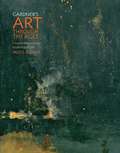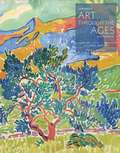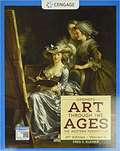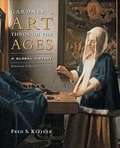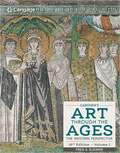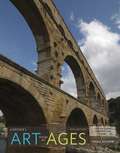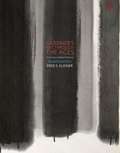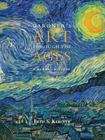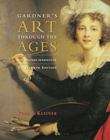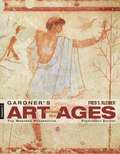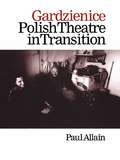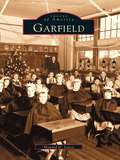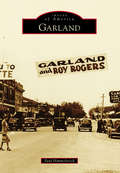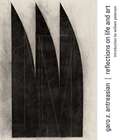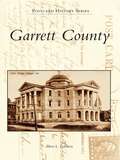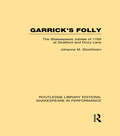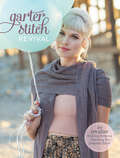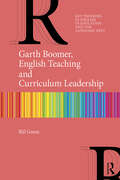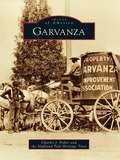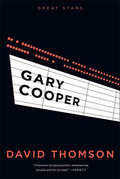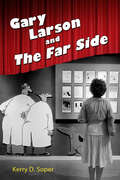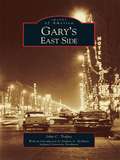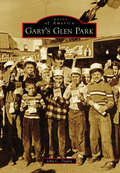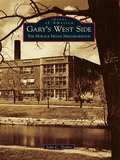- Table View
- List View
Gardner's Art Through The Ages: A Concise Western History
by Fred S. KleinerEasy to read and understand, the fourth edition includes new artists and provides a rich cultural backdrop for each of the covered periods and geographical locations.
Gardner's Art Through The Ages: A Global History
by Fred S. KleinerGARDNER'S ART THROUGH THE AGES: A GLOBAL HISTORY provides you with a comprehensive, beautifully illustrated tour of the world's great artistic traditions! Easy to read and understand, the 15th edition of the most widely read art history book in the English language continues to evolve, providing a rich cultural backdrop for each of the covered periods and geographical locations, and incorporating new artists and art forms -- all reproduced according to the highest standards of clarity and color fidelity. A complete online learning environment, including all images and an eBook, also is available. The unique Scale feature will help you better visualize the actual size of the artworks shown in the book. "The Big Picture" overviews at the end of every chapter summarize the chapter's important concepts.
Gardner's Art Through The Ages: The Western Perspective, Volume II
by Helen Gardner Fred S. KleinerAuthor and award-winning scholar-professor Fred Kleiner continues to set the standard for art history textbooks, combining impeccable and authoritative scholarship with an engaging approach that discusses the most significant artworks and monuments in their full historical and cultural contexts. GARDNER'S ART THROUGH THE AGES: THE WESTERN PERSPECTIVE, VOLUME II includes nearly 100 new images, new pedagogical box features, images that have been upgraded for clarity and color-fidelity, revised and improved maps and architectural reconstructions, and more. Over 40 reviewers -- both generalists and specialists -- contributed to the accuracy and readability of this edition. A unique scale feature will help students better visualize the actual size of the artworks shown in the book. Within each chapter, the ""Framing the Era"" overviews, timeline, extended captions, and the chapter summary section titled ""The Big Picture"" will help students review for exams.
Gardner's Art Through the Ages: A Global History
by Fred S. KleinerGARDNER'S ART THROUGH THE AGES: A GLOBAL HISTORY provides you with a comprehensive, beautifully illustrated tour of the world's great artistic traditions! Easy to read and understand, the 15th edition of the most widely read art history book in the English language continues to evolve, providing a rich cultural backdrop for each of the covered periods and geographical locations, and incorporating new artists and art forms -- all reproduced according to the highest standards of clarity and color fidelity. A complete online learning environment, including all images and an eBook, also is available. The unique Scale feature will help you better visualize the actual size of the artworks shown in the book. "The Big Picture" overviews at the end of every chapter summarize the chapter's important concepts.
Gardner's Art Through the Ages: A Global History (Enhanced 13th Edition)
by Fred S. KleinerThe 13TH ENHANCED EDITION of GARDNER'S ART THROUGH THE AGES: A GLOBAL HISTORY takes this brilliant bestseller to new heights in addressing the challenges of today's classroom. The art of western Europe, which was the basis for the original Gardner History, is now interspersed with chapters on the art and architecture of South and Southeast Asia, China and Korea, Japan, Oceania, Africa, the Islamic world, and Native American art.
Gardner's Art Through the Ages: The Western Perspective
by Fred S. KleinerExperience the wonders of human creativity in GARDNER'S ART THROUGH THE AGES: THE WESTERN PERSPECTIVE, VOLUME I, 16th Edition! A grand tour of the world's most celebrated works of Western Civilization from the Stone Age to the modern era, this introductory text has been a classroom favorite for 85 years. Every chapter includes rich and compelling discussions of pivotal art works, periods and geographies in art history, as well as new artists and art forms. The bold illustrations on the pages look almost as good as the real thing, especially when you use the unique Scale feature to imagine a work's stature from the artist's point of view. And to keep your course success in focus, the text offers Quick Review Captions and Big Picture Overviews, as well as an optional ebook that enables you to zoom in on fine details of paintings, sculptures, and priceless art forms of all kinds.
Gardner's Art Through the Ages: The Western Perspective, Volume 1 (Fifteenth Edition)
by Fred S. KleinerGARDNER'S ART THROUGH THE AGES: THE WESTERN PERSPECTIVE, VOLUME I, gives you the tools to master your course material. A unique scale feature will help you better visualize the actual size of the artworks shown in the book. Within each chapter, the "Framing the Era" overviews, timeline, extended captions, and the chapter summary section titled "The Big Picture" will help you review for exams.
Gardner's Art through the Ages: A Concise Global History
by Fred S. KleinerGARDNER'S ART THROUGH THE AGES: A CONCISE GLOBAL HISTORY, 4th Edition provides you with a comprehensive, beautifully illustrated tour of the world's great artistic traditions, and, with MindTap, all of the online study tools you need to excel in your art history course! Easy to read and understand, the fourth edition includes new artists and provides a rich cultural backdrop for each of the covered periods and geographical locations.
Gardner's Art through the Ages: A Global History
by Fred S. KleinerNotable to the 13th edition of this celebrated textbook is the upgrading of a large percentage of the images around which the text is based. Professors accustomed to the 12th edition will be relieved to learn that the content and its organization have not been altered. The volume includes online access to a site where students can find flashcards, visual compare and contrast examples, links to Google earth coordinates, interactive maps, video clips, and practice tips, among other study aids. The art of western Europe, which was the basis for the original Gardner History, is now interspersed with chapters on the art and architecture of South and Southeast Asia, China and Korea, Japan, Oceania, Africa, the Islamic world, and Native American art. Many maps and inset boxes, as well as an accompanying fold-out timeline are included. Earlier editions are cited in Resources for College Libraries. Annotation ©2008 Book News, Inc., Portland, OR (booknews.com)
Gardner's Art through the Ages: The Western Perspective (13th edition)
by Fred S. KleinerAs fascinating as a real visit to the world's famous museums and architectural sites, GARDNER'S ART THROUGH THE AGES: THE WESTERN PERSPECTIVE gives you a comprehensive, beautifully illustrated tour of the world's great artistic traditions--plus all the study tools you need to excel in your art history course! Easy to read and understand, this 13th Edition of the most widely read history of art book in the English language is the only textbook that includes a unique "scale" feature.
Gardner's Art through the Ages: The Western Perspective, Volume I
by Fred S. KleinerThis book provides you with a comprehensive, beautifully illustrated tour of the world's great artistic traditions! Easy to read and understand, the fourteenth edition of the most widely-read art history book in the English language continues to evolve, providing a rich cultural backdrop for each of the covered periods and geographical locations, and incorporating new artists and art forms--all reproduced according to the highest standards of clarity and color fidelity. A complete online environment, including all images and an eBook, is also available. The unique scale feature will help you better visualize the actual size of the artworks shown in the book. Within each chapter, the "Framing the Era" overviews, a new timeline, and the chapter-ending section entitled "The Big Picture", make it easier to understand the cultural and historical forces that influenced each artwork.
Gardzienice: Polish Theatre in Transition (Contemporary Theatre Studies #Vol. 22)
by Paul AllainIn 1977, the Gardzienice Theatre Association, an experimental theatre company was founded in a tiny Polish village. By 1992 The Observer was hailing "Brilliant Gardzienice...and orgy of joy, anguish, prayer and lamentation performed in candlelight with hurtling energy and at breakneck speed...Physically reckless, thrillingly well sung...On no account to be missed. " Today the Gardzienice Theatre Association is hailed as Poland's leading theatre group, training Royal Shakespeare Company actors and touring the world. Paul Allain describes and analyses their sung performances, strenuous physical and vocal training, and anthropological fieldwork amongst marginalized European minorities. This is one of the first detailed attempts to assess developments in Polish experimental theatres since 1989. The author questions whether those artists can maintain their vision in the face of Poland's economic difficulties and increased commercialization of the arts.
Garfield (Images of America)
by Howard D. LanzaGarfield was once home to the Lenni Lenape, a tribe within the Algonquin Nation of Native Americans. Later, the Revolutionary War touched the area when many British soldiers entered the district in pursuit of Washington's army. After the war, farmers prospered as the fertile land of the river valley produced abundant crops that were shipped down the Passaic River to markets in New York City. In the late 1800s, as cities lying across the river industrialized, Garfield's farms gave way to mills, a trolley and railroads built lines through town, and soon the soaring population attracted a variety of small businesses.In Garfield, some two hundred vintage photographs, most of which have never before been published, reveal the nature, culture, and character of a community that has been named the City of Champions. Included are views of the local schools, churches, markets, and police and fire departments, as well as many interesting local residents.
Garland (Images of America)
by Paul HimmelreichGarland began as an amalgamation of a number of rural communities in northeastern Dallas County. A compromise solution to the rivalry of two railroad towns, Duck Creek and Embree, it is now the 12th largest city in Texas and the 87th most populous city in the United States. Evolving from its origins as a farming community, by the 1950s, Garland had become an industrious suburb of the Dallas metro area. The can-do spirit of the community has enabled its stalwart pioneer settlers to overcome natural disasters and make necessary improvements that contributed to its growth and position in the county. Surrounded by interstates, toll roads, and connecting rail lines, Garland links the Dallas Metro with Northeast Texas. Its future continues to diversify and adapt to the growing environments of Texas.
Garo Z. Antreasian: Reflections on Life and Art
by Garo Z. AntreasianGaro Z. Antreasian (b. 1922) belongs to the great generation of innovators in mid-twentieth-century American art. While influenced by a variety of European artists in his early years, it was his involvement with Tamarind Lithography Workshop starting in 1960 that transformed his work. As Tamarind&’s founding technical director, he revolutionized the medium of lithography. He discovered how to manipulate the spontaneous possibilities of lithography in the manner of the Abstract Expressionist painters. In addition to reflecting on his work, he writes movingly about his Armenian heritage and its importance in his art, his teaching, and his love affair with all sorts of artistic media. Illustrating his drawings, paintings, and prints, this book reveals Antreasian as a major American artist.This book was made possible in part by generous contributions from the Frederick Hammersley Foundation and Gerald Peters Gallery.
Garrett County (Postcard History)
by Albert L. FeldsteinEstablished in 1872, Garrett, Maryland's westernmost county, was the last county created in the state and is named for John Work Garrett, then president of the Baltimore & Ohio Railroad. The images presented here were selected with care from the author's collection of several thousand postcards. Featured are Garrett's numerous towns and communities; downtown business scenes; residential views; historic buildings, churches, railroad stations; and the great resort hotels. Also included are the county's many historic and natural landmarks, rustic scenes, the Deep Creek Lake area, and varied sites along the historic National Road. A special element is the inclusion of many of the personal messages sent on the back of the postcards.
Garrick's Folly: The Shakespeare Jubilee of 1769 at Stratford and Drury Lane (Routledge Library Editions: Shakespeare in Performance)
by Johanne M. StochholmThe great Shakespeare Jubilee festival was held at Stratford, under the direction of David Garrick. The occasion was the dedication of the new town hall and the presentation by Garrick of a statue of Shakespeare. Immense interest, enthusiasm, and controversy were aroused by the plans, which involved not only theatrical and rhetorical festivities but fireworks, processions and a horserace. This book was originally published in 1964 to coincide with the 400th anniversary of Shakespeare’s birth. It describes the festival, which touched heights of success and depths of disaster, its impact on Stratford, its after effects in London, especially theatrical London, where rival managers tried to cash in on Garrick’s idea and where Garrick turned the Stratford failure into resounding success at Drury Lane. The author quotes entertainingly from newspapers, memoirs, and plays, and illustrates her book with contemporary engravings and portraits.
Garter Stitch Revival: 20 Creative Knitting Patterns Featuring the Simplest Stitch
by Interweave EditorsThe simplest stitch--the most spectacular results! Featuring a foreword from knitwear designer Holli Yeoh! Garter stitch is the first stitch pattern we learn as knitters--and now, we celebrate the beauty and sophistication of this simple stitch with Garter Stitch Revival. In this gorgeous collection, each project highlights garter stitch in its detail work, as a supporting role for other stitches, or as the star of the show. In projects such as Be True Fingerless Mitts and the Flapper Cloche, the beauty is in the details created with the use of the garter stitch. In the Beachcomber Braided Poncho, the Santa Monica Cardigan, and more, you'll discover how perfect the garter stitch can be for offsetting other stitch patterns. And when used as the main stitch in designs such as the Festival Halter Top and the Autumn Evening Shrug, the texture and lovely repetition result in stunning finished pieces. Whether you've always loved the garter stitch or you're returning to an old friend, the twenty gorgeous projects in Garter Stitch Revival certainly show that it's a classic for a million beautiful reasons.
Garth Boomer, English Teaching and Curriculum Leadership (Key Thinkers in English in Education and the Language Arts)
by Bill GreenThis book provides a broad introduction to the critical work of leading Australian educator Garth Boomer, widely recognised as a significant figure in English teaching. This insightful text provides an accessible introduction to his work, with particular reference to English curriculum and pedagogy, and provides a fascinating account of his journey as a scholar-practitioner, from classroom teaching to the highest levels of the educational bureaucracy.Bill Green explores Boomer’s huge influence on literacy education, teacher development, curriculum inquiry, and educational policy, and critically asks why Boomer’s insights and arguments about English teaching from the last century have such importance for the field now. This text also focuses on the nature and significance of his curriculum thinking, specifically his arguments and provocations regarding English teaching, the English classroom, and the contexts that infuse and shape them. It constitutes a rich resource for rethinking English teaching in the present day and provides an important contribution to the historical imagination.With all due consideration of the larger context of social life and educational thought, this text will help any student of English in Education and Language Arts obtain a deeper understanding of Boomer’s vital contribution to the field of education.
Garvanza (Images of America)
by Highland Park Heritage Trust Charles J. FisherNamed for the garbanzo bean that Julio Verdugo raised on his Rancho San Rafael, the town of Garvanza was laid out by Ralph Rogers in 1886. The community soon became a haven for artists and others seeking a refuge from the growing urban life of Los Angeles. Early institutions included the Church of the Angels and the Judson Studios, founded by painter William Lees Judson to create art through stained glass. The town's identity was eventually overtaken by neighboring Highland Park, but the community name was reestablished in the 1990s by today's residents, who are as in love with its beauty as those 110 years earlier.
Gary Cooper (Great Stars)
by David Thomson"Cooper was heroic, of course, in his own mind as much as in his scripts. He was manly, tall, ruggedly handsome. He was a man for a fight." On screen Gary Cooper was the ultimate all-American hero: lean, laconic, and masculine, a lone sheriff battling his enemies in High Noon, or a tough individualist in The Fountainhead. Off-screen he bedded a host of leading ladies and carefully honed his image, making hundreds of movies and winning two Oscars in the process. The acclaimed film writer David Thomson explores the career and the contradictions of "Coop," the star who lived the dream in the golden age of Hollywood.
Gary Larson and The Far Side (Great Comics Artists Series)
by Kerry D. SoperKerry D. Soper reminds us of The Far Side's groundbreaking qualities and cultural significance in Gary Larson and "The Far Side." In the 1980s, Gary Larson (b. 1950) shook up a staid comics page by introducing a set of aesthetic devices, comedic tones, and philosophical frames that challenged and delighted many readers, even while upsetting and confusing others. His irreverent, single panels served as an alternative reality to the tame comedy of the family-friendly newspaper comics page, as well as the pervasive, button-down consumerism and conformity of the Reagan era.In this first full study of Larson's art, Soper follows the arc of the cartoonist's life and career, describing the aesthetic and comedic qualities of his work, probing the business side of his success, and exploring how The Far Side brand as a whole--with its iconic characters and accompanying set of comedic and philosophical frames--connected with its core readers. In effect, Larson reinvented his medium by creatively working within, pushing against, and often breaking past institutional, aesthetic, comedic, and philosophical parameters.Due to the comic's great success, it opened the door for additional alternative voices in comics and other popular mediums. With its intentionally awkward, minimalistic lines and its morbid humor, The Far Side expanded Americans' comedic palette and inspired up-and-coming cartoonists, comedians, and filmmakers. Soper re-creates the cultural climate and media landscape in which The Far Side first appeared and thrived, then assesses how it impacted worldviews and shaped the comedic sensibilities of a generation of cartoonists, comedy writers, and everyday fans.
Gary's East Side
by John C. Trafny Stephen G. McshaneGary's East Side is a nostalgic look back at one of the Steel City's oldest neighborhoods. Through a captivating collection of photographs that chronicle the many aspects of life on the east side of Gary, the book presents the rich history of the community from 1906, the year of Gary's founding, to the present.From the steel mills to the churches to Gary's City Hall, Gary's East Side offers a touching look at this close-knit community. The east side of Gary was a place where people knew their neighbors, where children went to school together, and married high school sweethearts. The area has changed, but a new Gary is emerging. Gary's East Side presents the history of this area in poignant detail and points to the heartening future. Author John Trafny's skillful compilation promises to bring back fond memories of this historic neighborhood.
Gary's Glen Park
by John C. TrafnyAmerica's "Big Steel" gave birth to Gary in 1906, when the United States Steel Corporation established a plant in Indiana along the southern shore of Lake Michigan. The new city on the lake attracted thousands of job seekers from the coalfields and factories in the East to far-off lands in southern and eastern Europe. As they settled in Gary, immigrant groups established communities, built churches and schools, and instilled in their children the values of hard work, strong faith, and cultural traditions. Images of America: Gary's Glen Park looks back at the southern neighborhood of "Steel City" from its birth to the early 1970s. Each chapter looks at a specific part of the area's history, such as the neighborhood, local businesses, memorable events, and people. Other chapters focus on the foundations of any community: the churches and schools.
Gary's West Side: The Horace Mann Neighborhood (Images of America)
by John C. TrafnyThough Gary was an industrial city founded by U.S. Steel, the Horace Mann neighborhood evolved into one of the most exclusive residential areas in northwest Indiana. Skilled craftsmen from the mills were able to live among doctors and lawyers as well as businessmen and supervisors from U.S. Steel. From the boom years of the 1920s through the 1960s, residents of diverse economic backgrounds sent their children to the same schools, prayed together in the same houses of worship, and shopped in Gary's popular downtown. Gary's West Side: The Horace Mann Neighborhood is a pictorial history spanning four generations of one of the Steel City's premier residential districts. Through archival photographs, family snapshots provided by former residents, and shared memories, the reader is taken on a nostalgic journey from the city's founding in 1906 through to the 21st century.
